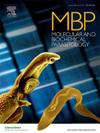In Silico and in vitro assessment of anti-leishmania infantum activity of a novel cyclohexyl-1,2,4-oxadiazole derivative
IF 1.4
4区 医学
Q4 BIOCHEMISTRY & MOLECULAR BIOLOGY
引用次数: 0
Abstract
Globally, an estimated 1 billion people reside in endemic areas, and over 12 million individuals are infected with leishmaniasis. Despite its prevalence, leishmaniasis continues to be a neglected disease, mainly affecting underdeveloped countries. In Brazil, the available treatments are pentavalent antimonials and amphotericin B, which are outdated, toxic, require prolonged parenteral administration and have limited efficacy. The heterocyclic ring oxadiazole has been documented in the literature to possess various biological activities, including leishmanicidal properties, thus positioning it as a potential candidate for further investigation. This study aims to evaluate the in vitro leishmanicidal activity of an oxadiazole compound (2i), explore its mechanism of action through enzymatic inhibition and molecular docking, assess its antioxidant activity, and conduct an in silico pharmacokinetic prediction. Pharmacokinetic predictions via ADME/TOX modeling revealed that the 2i molecule exhibits good intestinal absorption (92 %), is water-insoluble (-4 log.mol/L) and demonstrates high permeability in Caco-2 cells (1.35 log.Papp10–6cm/s), suggesting potential for oral administration. Metabolic studies indicated that oxadiazole 2i is an inhibitor of cytochrome P450 enzymes CYP1A2 and CYP2C19, necessitating further evaluation of potential drug interactions. Additionally, it did not exhibit hepatotoxicity or cardiotoxicity; however, it demonstrated mutagenic potential in the salmonella reverse mutation test (AMES), which is a genetic method that detects mutagenic chemical agents, thus justifying more complex confirmatory studies. In vitro assays showed that oxadiazole 2i has DPPH (2,2-diphenyl-1-picrylhydrazyl) radical reducing activity, indicating potential antioxidant properties with an IC50 of 12.10 µg/mL. Concerning its leishmanicidal mechanism of action, molecular docking simulations at the active site of acetylcholinesterase demonstrated that the 2i molecule had superior binding energy values compared to the reference drug physostigmine (-7.39 kcal/mol versus −6.66 kcal/mol, respectively). However, the pharmacophore map revealed that physostigmine had more molecular interactions than oxadiazole 2i. In acetylcholinesterase inhibition assays, the 2i molecule exhibited significant inhibitory activity with an IC50 of 11.91 µg/mL, suggesting a mechanism of action that compromises the parasitic membrane. Moreover, the 2i molecule demonstrated significant leishmanicidal activity against L. infantum with an IC50 of 30.86 μM. Cytotoxicity assays on RAW 264.7 macrophages revealed a high CC50 value of 485.5 µM and a selectivity index (SI) of 17.86. Based on these findings, oxadiazole 2i emerges as a promising candidate for further study, offering prospects for more affordable, selective, and less toxic leishmanicidal agents.
一种新型环己基-1,2,4-恶二唑衍生物抗婴儿利什曼原虫活性的体内和体外评价。
在全球范围内,估计有10亿人居住在流行地区,1200多万人感染了利什曼病。尽管利什曼病很流行,但它仍然是一种被忽视的疾病,主要影响不发达国家。在巴西,现有的治疗方法是五价锑和两性霉素B,但这两种药物已经过时,有毒性,需要长时间的肠外给药,而且疗效有限。杂环恶二唑在文献中被证明具有多种生物活性,包括利什曼尼的特性,因此将其定位为进一步研究的潜在候选者。本研究旨在评价一种恶二唑类化合物(2i)的体外杀利什曼尼菌活性,通过酶抑制和分子对接探索其作用机制,评估其抗氧化活性,并进行计算机药代动力学预测。通过ADME/TOX模型进行的药代动力学预测显示,2i分子具有良好的肠道吸收(92%),不溶于水(-4 log.mol/L),在Caco-2细胞中具有高通透性(1.35log.Papp10-6cm/s),表明口服给药的潜力。代谢研究表明,恶二唑2i是细胞色素P450酶CYP1A2和CYP2C19的抑制剂,需要进一步评估潜在的药物相互作用。此外,它没有表现出肝毒性或心脏毒性;然而,它在沙门氏菌反向突变试验(AMES)中显示出致突变潜力,这是一种检测致突变化学剂的遗传方法,因此有理由进行更复杂的验证性研究。体外实验表明,恶二唑2i具有降低DPPH(2,2-二苯基-1-picrylhydrazyl)自由基的活性,IC50为12.10µg/mL。在乙酰胆碱酯酶活性位点的分子对接模拟表明,2i分子的结合能值优于参比药物-7.39kcal/mol和-6.66kcal/mol。药效团图谱显示,毒豆碱比恶二唑2i具有更多的分子相互作用。在乙酰胆碱酯酶抑制实验中,2i分子表现出显著的抑制活性,IC50为11.91µg/mL,表明其作用机制损害了寄生膜。此外,2i分子对婴儿乳杆菌具有显著的利什曼尼杀灭活性,IC50为30.86μM。对RAW 264.7巨噬细胞进行细胞毒性实验,CC50值高达485.5µM,选择性指数(SI)为17.86。基于这些发现,恶二唑2i成为一个有希望的进一步研究的候选者,为更经济、选择性和毒性更低的利什曼尼杀灭剂提供了前景。
本文章由计算机程序翻译,如有差异,请以英文原文为准。
求助全文
约1分钟内获得全文
求助全文
来源期刊
CiteScore
2.90
自引率
0.00%
发文量
51
审稿时长
63 days
期刊介绍:
The journal provides a medium for rapid publication of investigations of the molecular biology and biochemistry of parasitic protozoa and helminths and their interactions with both the definitive and intermediate host. The main subject areas covered are:
• the structure, biosynthesis, degradation, properties and function of DNA, RNA, proteins, lipids, carbohydrates and small molecular-weight substances
• intermediary metabolism and bioenergetics
• drug target characterization and the mode of action of antiparasitic drugs
• molecular and biochemical aspects of membrane structure and function
• host-parasite relationships that focus on the parasite, particularly as related to specific parasite molecules.
• analysis of genes and genome structure, function and expression
• analysis of variation in parasite populations relevant to genetic exchange, pathogenesis, drug and vaccine target characterization, and drug resistance.
• parasite protein trafficking, organelle biogenesis, and cellular structure especially with reference to the roles of specific molecules
• parasite programmed cell death, development, and cell division at the molecular level.

 求助内容:
求助内容: 应助结果提醒方式:
应助结果提醒方式:


